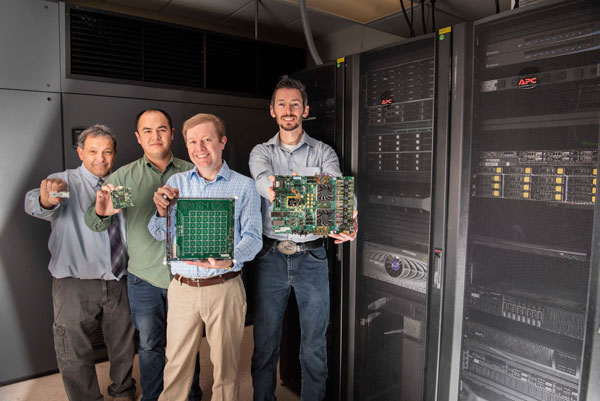Technique should benefit smartphones and self-driving cars
Whetstone, a software tool that sharpens the output of artificial neurons, has enabled neural computer networks to process information up to a hundred times more efficiently than the current industry standard.
The aptly named software, which greatly reduces the amount of circuitry needed to perform autonomous tasks, is expected to increase the penetration of artificial intelligence into markets for mobile phones, self-driving cars and automated interpretation of images.
“Instead of sending out endless energy dribbles of information,” Sandia neuroscientist Brad Aimone said, “artificial neurons trained by Whetstone release energy in spikes, much like human neurons do,”
The largest artificial intelligence companies have produced spiking tools for their own products, but none are as fast or efficient as Whetstone, said Sandia mathematician William Severa. “Large companies are aware of this process and have built similar systems, but often theirs work only for their own designs. Whetstone will work on many neural platforms.”
The open-source code was recently featured in a technical article in Nature Machine Intelligence and has been submitted by Sandia for a patent.

How to sharpen neurons
Artificial neurons basically are capacitors that absorb and sum electrical charges, then release them in tiny bursts of electricity. Computer chips, termed “neuromorphic systems,” assemble neural networks into large groupings that mimic the human brain by sending electrical stimuli to neurons firing in no predictable order. This contrasts with the more lock-step procedure used by desktop computers with their pre-set electronic processes.
Because of their haphazard firing, neuromorphic systems often are slower than conventional computers, but they require far less energy to operate. They also require a different approach to programming because otherwise, their artificial neurons fire too often or not often enough, which has been a problem in bringing them online commercially.
Whetstone, which functions as a supplemental computer code tacked on to more conventional software training programs, trains and sharpens artificial neurons by leveraging those that spike only when a sufficient amount of energy — that is, information — has been collected. The training has proved effective in improving standard neural networks and is being benchmarked for the emerging technology of neuromorphic systems.
Catherine Schuman, a neural network researcher at Oak Ridge National Laboratory, said, “Whetstone is an important tool for the neuromorphic community. It provides a standardized way to train traditional neural networks that are amenable for deployment on neuromorphic systems, which had previously been done in an ad hoc manner.”
The strict teacher
The Whetstone process, Brad said, can be visualized as controlling a class of talkative elementary school students who are tasked with identifying an object on a strict teacher’s desk. Prior to Whetstone, the students sent a continuous stream of sensor input to their formerly overwhelmed teacher, who had to listen to all of it — every bump and giggle, so to speak — before passing a decision into the neural system. Processing this huge amount of information often requires cloud-based computation, or the addition of more local computing equipment combined with a sharp increase in electrical power. Both options increase the time and cost of commercial artificial intelligence products, lessen their security and privacy and make their adoption less likely.
Under Whetstone, the teacher ignores most of the chatter and only pays attention to a simple “yes” or “no” measurement of each student — when they raise their hands with a solution.
Suppose, for example, the intent is to identify whether a piece of green fruit on the teacher’s desk is an apple. Each student is a sensor that may respond to a different quality of what may be an apple: Does it have the correct qualities of smell, taste, texture and so on? And while the student who looks for red may vote “no,” the student who looks for green would vote “yes.” When the number of answers, either yay or nay, is electrically high enough to trigger the neuron’s capacity to fire, that simple result, instead of endless waffling, enters the overall neural system.
While Whetstone simplifications potentially could increase errors, the overwhelming number of participating neurons — often more than a million — provide information that statistically makes up for the inaccuracies introduced by the data simplification, said William, who is responsible for the mathematics of the program.
“Combining overly detailed internal information with the huge number of neurons reporting in is a kind of double booking,” he said. “It’s unnecessary. Our results tell us the classical way — calculating everything without simplifying — is wasteful. That is why we can save energy and do it well.”
Patched programs work best
The software program works best when patched into programs meant to train new artificial-intelligence equipment, so Whetstone doesn’t have to overcome learned patterns with already established energy minimums.
The work is a continuation of a Sandia project called Hardware Acceleration of Adaptive Neural Algorithms, which explored neural platforms in work supported by Sandia’s Laboratory Directed Research and Development program. DOE’s Advanced Simulation and Computing program funds the current work.
In addition to Brad and William, paper authors are Sandia researchers Craig Vineyard, Ryan Dellana and Stephen Verzi.